Acura RSX 2002 Owner's Manual
Manufacturer: ACURA, Model Year: 2002, Model line: RSX, Model: Acura RSX 2002Pages: 320, PDF Size: 4.38 MB
Page 261 of 320

If you use a liquid air f reshener,
make sure you f asten it securely so it
does not spill as you drive.
Clean the windows, inside and out,
with a commercially-available glass
cleaner. You can also use a mixture
of one part white vinegar to ten parts
water. This will remove the haze that
builds up on the inside of the
windows. Use a sof t cloth or paper
towels to clean all glass and clear
plastic surf aces.
Dirt build-up in the loops of the seat
belt anchors can cause the belts to
retract slowly. Wipe the insides of
the loops with a clean cloth
dampened in mild soap and warm
water or isopropyl alcohol.
If you want to use an air f reshener/
deodorizer in the interior of your car,
it is best to use a solid type. Some
liquid air f resheners contain chemi-
cals that may cause parts of the
interior trim and f abric to crack or
discolor.
If you want to clean the instrument
panel with a sof t towel (wool or
f eather), dust f rom wool and f eather
are entered in the lattice pattern of
the instrument panel. Because it is
difficult to clean off dust from the
instrument panel. We recommend to
use a sof t bristle brush. A ir Fresheners
Windows
Instrument Panel
Interior Care
Appearance Care258
The rear window def ogger and
antenna wires are bonded to the inside
of the glass. Wiping vigorously up-and-
down can dislodge and break these
wires. When cleaning the rear window,
use gentle pressure and wipe side-to-
side.
Page 262 of 320

Repair chips and scratches in the
paint as soon as you discover them.
Inspect and clean out the drain
holes in the bottom of the doors
and body.
Check the floor coverings for
dampness. Carpeting and f loor
mats may remain damp f or a long
time, especially in winter. This
dampness can eventually cause
the f loor panels to corrode.
Two f actors normally contribute to
causing corrosion in your car:
Moisture trapped in body cavities.
Dirtandroadsaltthatcollectsin
hollows on the underside of the
car stays damp, promoting
corrosion in that area.
Removal of paint and protective
coatings f rom the exterior and
underside of the car. Many corrosion-preventive measures
are built into your Acura. You can
help keep your car f rom corroding
by perf orming some simple periodic
maintenance:
Use a high-pressure spray to clean
the underside of your car. This is
especially important in areas that
useroadsaltinwinter.Itisalsoa
good idea in humid climates and
areas subject to salt air. Cars
equipped with ABS have a sensor
and wiring at each wheel. Be
caref ul not to damage them.
Have the corrosion-preventive
coatings on the underside of your
car inspected and repaired
periodically.
1.
2.
Corrosion Prot ect ion
Appearance Care259
Page 263 of 320

Make sure the repair f acility uses
genuine Acura replacement body
parts. Some companies make sheet
metal pieces that seem to duplicate
the original Acura body parts, but
are actually inf erior in f it, f inish, and
corrosion resistance. Once installed,
they do not give the same high-
quality appearance.Takeyourcartoyourauthorized
Acura dealer f or inspection af ter the
repairs are completed. Your dealer
can make sure that quality materials
were used, and that corrosion-
preventive coatings were applied to
all repaired and replaced parts.
Body repairs can af f ect your car’s
resistance to corrosion. If your car
needs repairs af ter a collision, pay
close attention to the parts used in
the repair and the quality of the
work.
When reporting your collision to the
insurance company, tell them you
want genuine Acura parts used in the
repair. Although most insurers
recognize the quality of original
parts, some may try to specif y that
the repairs be done with other
available parts. You should investi-
gate this before any repairs have
begun.
Body Repairs
Appearance Care260
Page 264 of 320

This section covers the more-
common problems that motorists
experience with their vehicles. It
gives you inf ormation about how to
safely evaluate the problem and what
to do to correct it. If the problem has
stranded you on the side of the road,
you may be able to get going again.
If not, you will also f ind instructions
on getting your car towed.......................
Compact Spare Tire .262
....................
Changing a Flat Tire .263
..........
If Your Engine Won’t Start . 268
Nothing Happens or the Starter Motor Operates ............................
Very Slowly .268
The Starter Operates ................................
Normally .269
................................
Jump Starting .270
............
If Your Engine Overheats . 272
.........
Low Oil Pressure Indicator . 274
..........
Charging System Indicator . 275
.......
Malf unction Indicator Lamp . 276
...............
Brake System Indicator . 278
..................
Closing the Moonroof . 279
..............................................
Fuses .280
..........
Checking and Replacing . 281
......................
Emergency Towing .285
Taking Care of the Unexpected
T aking Care of t he Unexpect ed261
Page 265 of 320
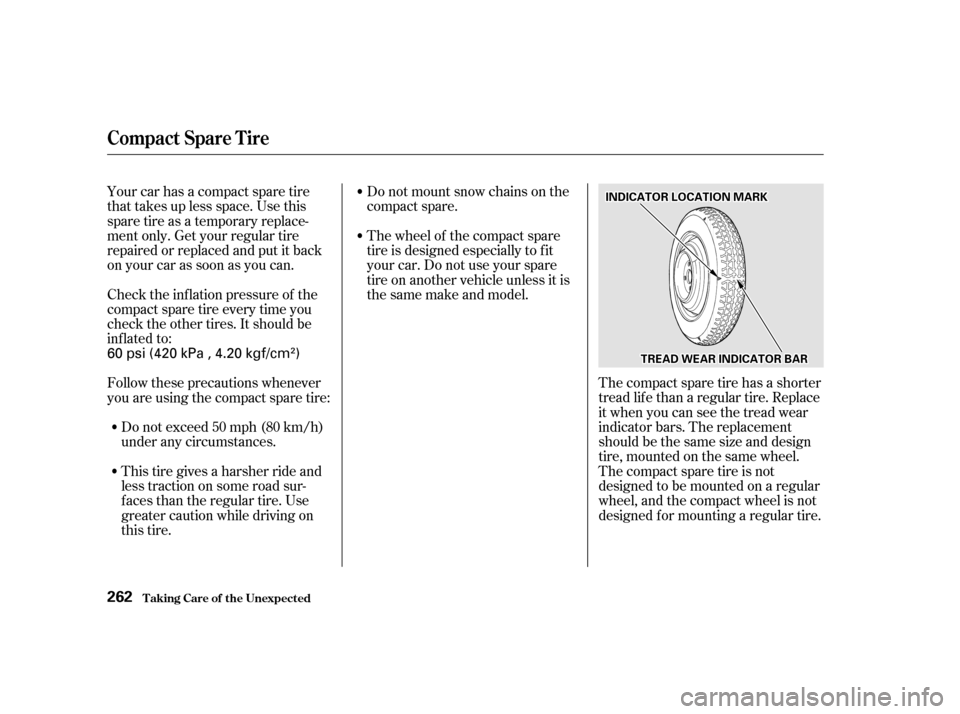
Thecompactsparetirehasashorter
tread lif e than a regular tire. Replace
it when you can see the tread wear
indicator bars. The replacement
should be the same size and design
tire, mounted on the same wheel.
Thecompactsparetireisnot
designed to be mounted on a regular
wheel, and the compact wheel is not
designed f or mounting a regular tire.
Check the inf lation pressure of the
compact spare tire every time you
check the other tires. It should be
inf lated to:
Follow these precautions whenever
you are using the compact spare tire:
Do not exceed 50 mph (80 km/h)
under any circumstances.
This tire gives a harsher ride and
less traction on some road sur-
f aces than the regular tire. Use
greater caution while driving on
this tire. Do not mount snow chains on the
compact spare.
Your car has a compact spare tire
that takes up less space. Use this
sparetireasatemporaryreplace-
ment only. Get your regular tire
repaired or replaced and put it back
on your car as soon as you can. The wheel of the compact spare
tire is designed especially to f it
your car. Do not use your spare
tire on another vehicle unless it is
thesamemakeandmodel.
Compact Spare Tire
T aking Care of t he Unexpect ed262
I IN
ND DI
ICCA A T
TO
OR R L
LOOC CAA T
TI
IOON N M
MA
AR
RKK
T
T R
RE EA
A D
D W
WE EA
A R
R I
INND DI
ICCA A T
TO
OR R B
BAA R
R
60 psi (420 kPa , 4.20 kgf/cm)
Page 266 of 320
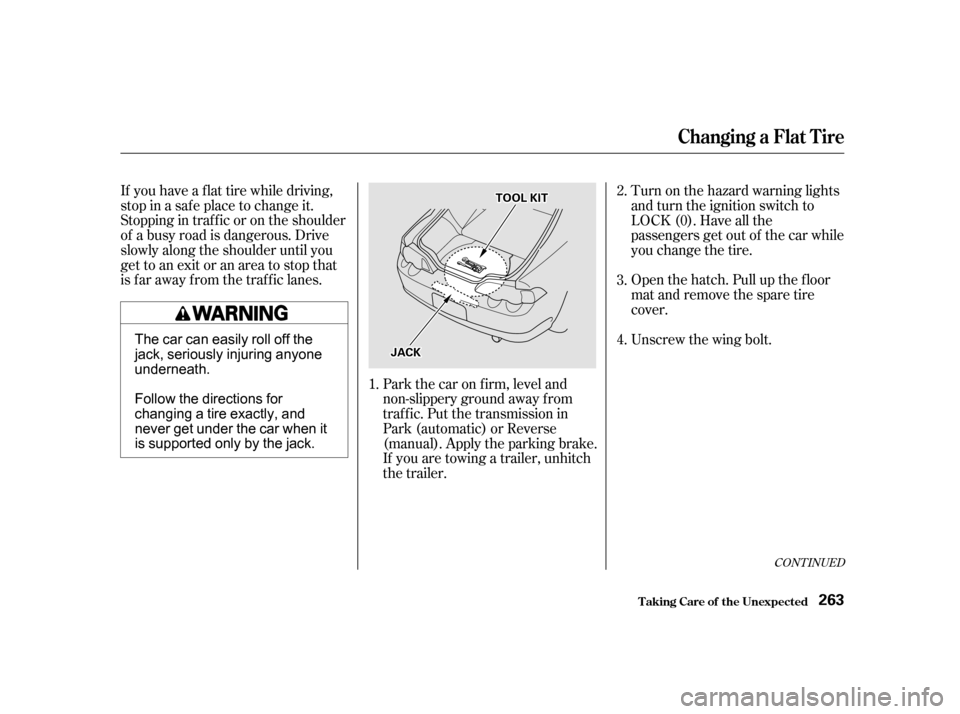
If you have a f lat tire while driving,
stop in a saf e place to change it.
Stopping in traf f ic or on the shoulder
of a busy road is dangerous. Drive
slowly along the shoulder until you
gettoanexitoranareatostopthat
is far away from the traffic lanes.Park the car on f irm, level and
non-slippery ground away f rom
traf f ic. Put the transmission in
Park (automatic) or Reverse
(manual). Apply the parking brake.Open the hatch. Pull up the f loor
mat and remove the spare tire
cover. Turn on the hazard warning lights
andturntheignitionswitchto
LOCK (0). Have all the
passengers get out of the car while
you change the tire.
If you are towing a trailer, unhitch
the trailer. Unscrew the wing bolt.
1. 2.
3.
4.
CONT INUED
Changing a Flat T ire
T aking Care of t he Unexpect ed263
J JA
A C
CKK T
T
O
OO OLL K
KIITTThe car can easily roll off the
jack, seriously injuring anyone
underneath.
Follow the directions for
changing a tire exactly, and
never get under the car when it
is supported only by the jack.
Page 267 of 320
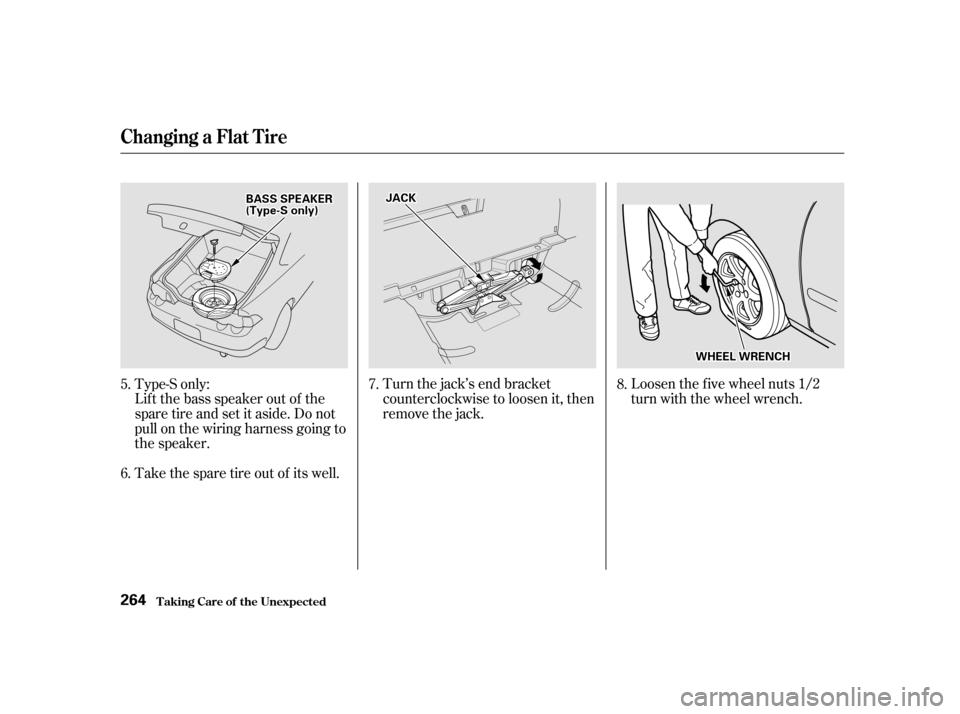
Turn the jack’s end bracket
counterclockwise to loosen it, then
remove the jack.Loosen the f ive wheel nuts 1/2
turn with the wheel wrench.
Take the spare tire out of its well. Lift the bass speaker out of the
spare tire and set it aside. Do not
pull on the wiring harness going to
the speaker.
5.
6. 7.
8.
Type-S only:
T aking Care of t he Unexpect ed
Changing a Flat T ire
264
J JA A C
CKK
W
WHHE
EE
EL
L W
WR REEN
NC CHH
B
BA
A S
SSS S
SPPE
EA
A K
KEER
R
(
( T
T y
ypp e
e--S
S o
on
nl
lyy) )
Page 268 of 320
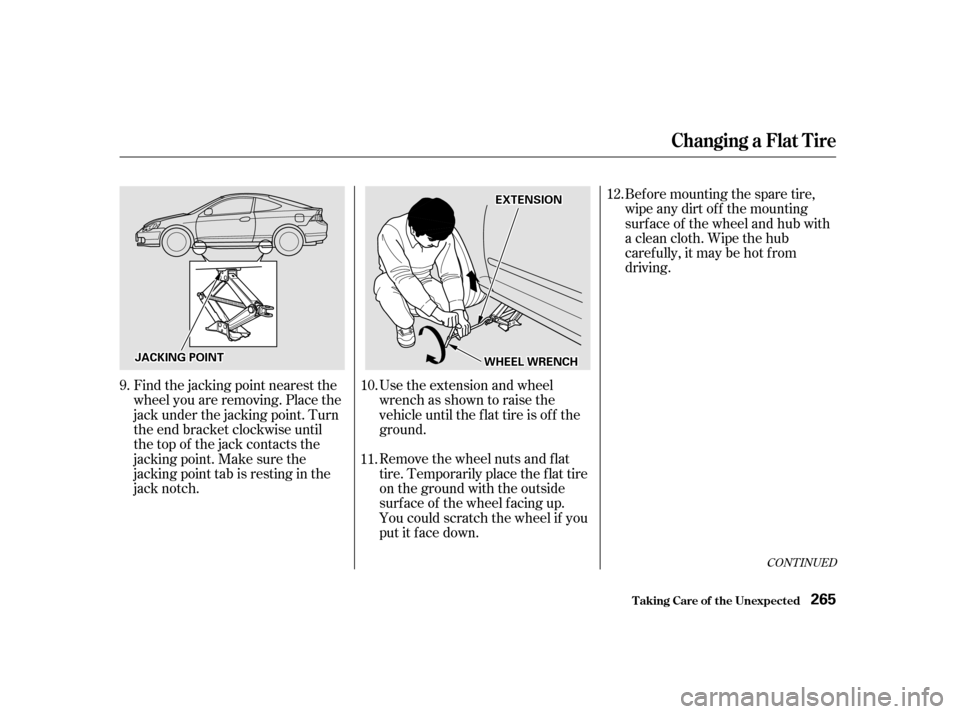
CONT INUED
Use the extension and wheel
wrench as shown to raise the
vehicle until the f lat tire is of f the
ground.
Remove the wheel nuts and f lat
tire. Temporarily place the flat tire
on the ground with the outside
surf ace of the wheel f acing up.
You could scratch the wheel if you
putitfacedown.
Find the jacking point nearest the
wheel you are removing. Place the
jack under the jacking point. Turn
the end bracket clockwise until
the top of the jack contacts the
jacking point. Make sure the
jacking point tab is resting in the
jack notch. Bef ore mounting the spare tire,
wipe any dirt of f the mounting
surface of the wheel and hub with
a clean cloth. Wipe the hub
carefully,itmaybehotfrom
driving.
9. 10.
11. 12.
Changing a Flat T ire
T aking Care of t he Unexpect ed265
E E
X
X T
TE
EN
NS SIIOON N
W
WH HE
EE
EL
L W
WR REEN
NC CHH
J
JA
A C
CKKIINNG G P
PO
OI INNT T
Page 269 of 320
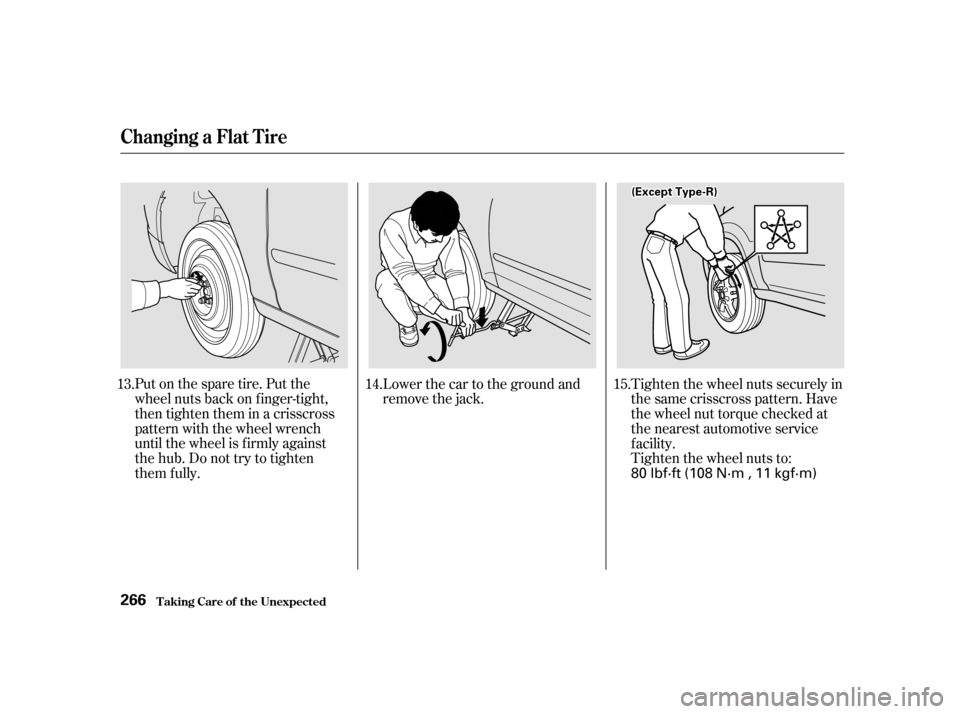
Put on the spare tire. Put the
wheel nuts back on f inger-tight,
then tighten them in a crisscross
pattern with the wheel wrench
until the wheel is f irmly against
the hub. Do not try to tighten
them f ully.Tighten the wheel nuts securely in
the same crisscross pattern. Have
the wheel nut torque checked at
the nearest automotive service
f acility.
Tighten the wheel nuts to:
Lower the car to the ground and
remove the jack.
13.
14.15.
T aking Care of t he Unexpect ed
Changing a Flat T ire
266
( (E
E x
xcceep p t
t T
Ty
ypp e
e--R
R) )
80 lbf·ft (108 N·m , 11 kgf·m)
Page 270 of 320
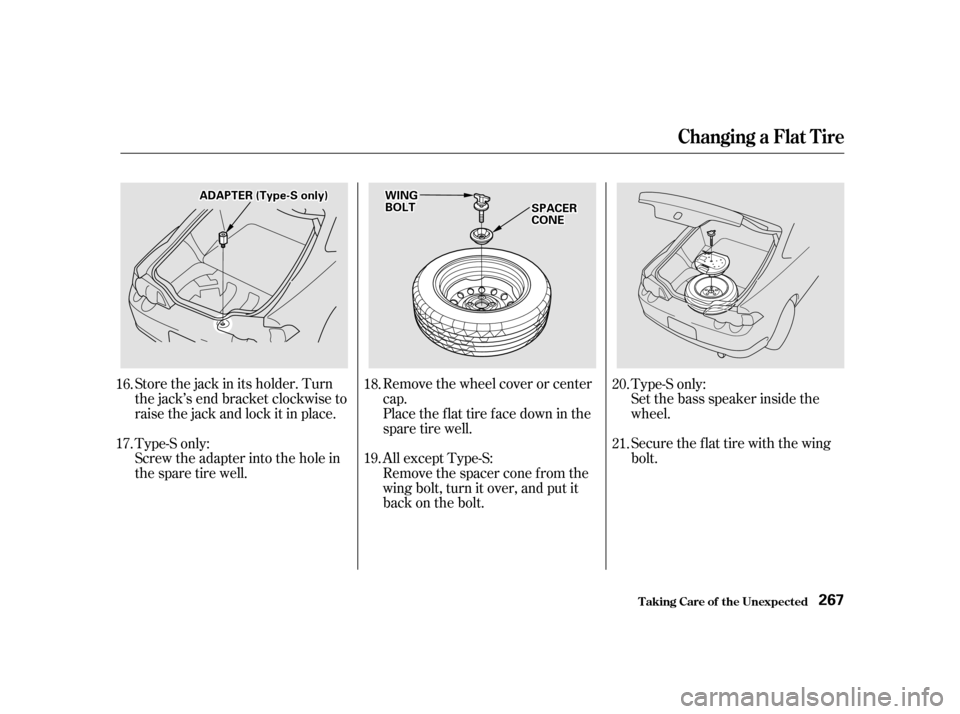
Remove the wheel cover or center
cap.
Place the flat tire face down in the
spare tire well.
Store the jack in its holder. Turn
the jack’s end bracket clockwise to
raisethejackandlockitinplace.
Screw the adapter into the hole in
the spare tire well.
Remove the spacer cone from the
wing bolt, turn it over, and put it
back on the bolt.Secure the f lat tire with the wing
bolt. Set the bass speaker inside the
wheel.
18.
19.
16.
17.
20.
21.
Type-S only:
All except Type-S:Type-S only:
T aking Care of t he Unexpect ed
Changing a Flat T ire
267
A A
D
DA
AP
PT
TE
ER
R (
(T
T y
ypp e
e--S
S o
on
nl
lyy) )
S
SPPA
A C
CEER
R
C
CO ON NEE
W
WI
INNG G
B
BO OL LTT